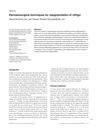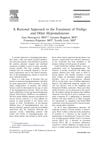Long-Term Follow-Up of Leucoderma Patients Treated with Transplants of Autologous Cultured Melanocytes, Ultrathin Epidermal Sheets, and Basal Cell Layer Suspension
November 2002
in “
British journal of dermatology/British journal of dermatology, Supplement
”
TLDR Transplantation is effective for stable leucoderma but not for progressive, widespread vitiligo vulgaris.
The study followed 132 leucoderma patients treated with three different melanocyte transplantation methods over 1-7 years. Stable leucoderma types, such as segmental vitiligo and piebaldism, showed 100% repigmentation regardless of the method, making surgery the preferred treatment. Vitiligo vulgaris patients had varied outcomes; ultrathin epidermal sheets were generally more effective but less so on knees and elbows. Trunk and limbs (excluding elbows and knees) responded best, while fingers and elbows were hardest to treat. Patients with extensive or progressive vitiligo vulgaris, especially those with hypothyroidism, had poorer outcomes. Slight hyperpigmentation was common, but no scarring occurred. Transplantation is recommended for stable leucoderma but not for progressive, widespread vitiligo vulgaris.




